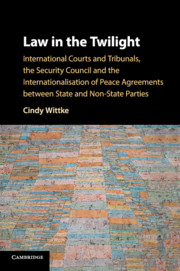 Law in the Twilight
Law in the Twilight Book contents
- Law in the Twilight
- Law in the Twilight
- Copyright page
- Dedication
- Contents
- Acknowledgements
- Table of Cases
- Official Documents
- Peace Agreements
- Abbreviations and Acronyms
- A Peace Agreements between State and Non-State Parties
- B General Considerations for Approaching the Internationalisation and Legalisation of Peace Agreements between State and Non-State Parties
- C Only Scraps of Paper?
- D The Security Council and the Internationalisation of Peace Agreements between State and Non-State Parties
- E Conclusion and Outlook
- Bibliography
- Index
E - Conclusion and Outlook
The Internationalisation of Peace Agreements between State and Non-State Parties
Published online by Cambridge University Press: 07 June 2018
- Law in the Twilight
- Law in the Twilight
- Copyright page
- Dedication
- Contents
- Acknowledgements
- Table of Cases
- Official Documents
- Peace Agreements
- Abbreviations and Acronyms
- A Peace Agreements between State and Non-State Parties
- B General Considerations for Approaching the Internationalisation and Legalisation of Peace Agreements between State and Non-State Parties
- C Only Scraps of Paper?
- D The Security Council and the Internationalisation of Peace Agreements between State and Non-State Parties
- E Conclusion and Outlook
- Bibliography
- Index
Summary
- Type
- Chapter
- Information
- Law in the TwilightInternational Courts and Tribunals, the Security Council and the Internationalisation of Peace Agreements between State and Non-State Parties, pp. 209 - 216Publisher: Cambridge University PressPrint publication year: 2018


